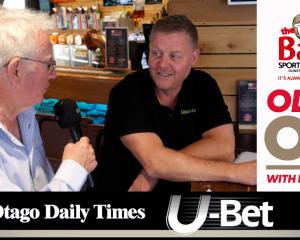
If our athletes are so clean, why did New Zealand Customs stop more illegal steroids at the border in 2013 than during the previous four years?
It is a reasonable question and one which has not sat well with the entrenched view that New Zealand athletes are somehow too honest to dope.
Rest assured, there most certainly is a market for anabolic steroids in New Zealand.
But the question is whether our elite athletes are in the market for an illegal boost.
Emeritus Professor David Gerrard and Drugfree Sport New Zealand [DFSNZ] chief executive Graeme Steel believe our culture and robust testing regime has helped keep our athletes from straying.
They point to a lack of high-profile athletes testing positive as sound evidence, and while neither can offer any assurances, both men passionately believe New Zealand sport is, for the most part, drug-free at the top level.
Our sporting community is not immune to the temptation of anabolic steroids, though.
Information provided to the Otago Daily Times by New Zealand Customs under the Official Information Act revealed a spike in the amount of steroids being intercepted between 2011 and 2013.
In 2010 Customs intercepted 89 items and 198g.
In 2011, that had risen to 149 items, 13,487.2g and 4,100ml.
The following year was also busy with 3879 items, 8234g and 493ml intercepted.
In 2013 Customs stopped 3174 items, 40,613.2g and 2482ml at the border.
There was a huge decline in 2014 and figures from 2015 are preliminary but show further falls.
The raw statistics do not reveal how concentrated the substances and items were or whether the increase in interceptions was down to improved detection and better intelligence, or simply because more product was flowing into the country.
Customs has not estimated, nor does it consider it possible to accurately estimate, how many steroids are slipping into the country undetected.
However, Steel believes illegal steroids are probably destined for the image-conscious among us and not the lockers of our elite athletes.
"We don't see any correlation, really, between what comes across the border and what we actually see in the sporting environment,'' he said.
"Very few athletes use anabolic steroids. That does not mean to say that there aren't some. But certainly all the indications we've got is the vast bulk of that would not be going to elite level athletes and more to gym bunnies.''
Gerrard is of the same view.
"I think the biggest market for these sorts of drugs is still the non-sporting community,'' he said.
"It is the person who wants to buff up, the person who wants to enhance his or her body shape.
"I heard it said reasonably recently, and I think it was David Howman the now retired director general of Wada, the intelligence they get from the United States indicates there is more money to be made on the black market from anabolic steroids than there is from cocaine and heroin.
"This [spike in steroid interceptions] would not indicate to me that this is a clandestine network of elite athletes who are using anabolic steroids. And the reason I say that is ... the vast majority of the testing at the elite level is out of competition and unannounced.
"You'd have to be a pretty smart operator to think you could beat the system.''
Where Gerrard believes there is a vulnerability in the system is with the next crop of emerging athletes who are not yet subject to regular testing if at all.
"It is a period of great vulnerability for an impressionable young athlete who is on the brink of being given an opportunity.
"They are going to be amenable to the discussion that might be had at the gym where someone who really doesn't care says.
"Use this, it works. You'll bulk up and then you can stop taking it and you won't get picked up'.''
"That's the concern for us,'' Steel agreed.
"Not that we know or think it [doping] is happening in high volumes. But that potential is very clear.
"They are a vulnerable group which is why in the next phase of our work we want to be paying much more attention to them, first through education and conceivably through testing.''
DFSNZ will receive a yearly million-dollar funding boast to help finance more testing through to 2020.
Last year the organisation performed 940 tests on New Zealand athletes and a further 277 for other anti-doping agencies.
While 900 odd tests might sound like a lot, DFSNZ monitors 150 athletes and they are tested on average about three times each.
The highest-profile athletes, such as Hamish Bond, Valarie Adams, Mahe Drysdale and Lisa Carrington, can expect to be tested six or seven times or "perhaps more''.
That does not leave a lot of tests for the rest of the sporting population.
Steel accepted the situation was not ideal but the funding increase would enable the organisation to lift its minimum target from 900 to 1450.
"We think that gives us a better shot at having the presence that we need to have across a broader range of athletes in the community.''
One of the key future battlegrounds is at our schools.
DFSNZ is testing some provincial rugby players at under-19 level but would like to extend is testing regime to first XV level.
That would require developing a relationship with the schools first and is probably some way off.
However, Steel remains mindful of how vulnerable some of our young rugby players could be.
"A lot of our athletes are brought up in an environment which is, I suppose, more about nurturing young people rather than pushing them to perform at an early age. We think, for example, that rugby is beginning to cross that line, where very young people are being shown huge incentives to get bigger and stronger.''
Potentially, a promising rugby player could use steroids to get a head start and then 'go straight' once they reach a level where they were likely to be tested.
If they carried on, they would probably be caught and Steel believes New Zealand has a unique sporting environment which makes it hard for cheats to survive.
"You can name on one hand, over the last 15 years, the top athletes who have doped. That is not true in many countries.
"There are also things about the New Zealand sporting environment which are not the norm and which we think give us a better opportunity to be clean.
"We just think that there is quite a good sporting culture that simply doesn't accept cheating. And athletes who demonstrate high values are the ones who are given the greatest prominence.''
Not all prohibited substances are illegal, of course, and Steel described the supplements industry as "the Wild West''.
A recent survey which targeted sports supplements available in Australia revealed 19% of the products contained substances banned by Wada.
He had no reason to believe it would be any different in New Zealand - a sobering thought.
"Sport should stand for something good in the community where people can have fun and come together. If a sporting club is somewhere you go to, not because it is a safe haven from drugs, but because that is where you go to get introduced to drugs, that is completely antithetical to what sports should be about.
"Our kids shouldn't be in some kind of pharmaceutical chicken to show that they have talent and so that they can express themselves. If we didn't prohibit it, that is what it would become.''
Drugfree Sport NZ
Testing regime
• Performed 940 tests last year (minimum requirement 900) plus an additional 277 for other anti-doping agencies.
• A million-dollar funding boost will enable DFSNZ to lift its target from 900 to 1450 tests next year.
• DFSNZ monitors 150 athletes who are tested on average about three times a year.
• Highest-profile athletes, like Lisa Carrington or Valarie Adams, are tested more frequently.
• Emerging athletes are not subject to the same rigorous testing regime and are potentially vulnerable.
• Schoolboy rugby shapes as a key battleground for DFSNZ and the organisation has tentative plans to roll out testing at first XV level.
New Zealand Customs
Illegal steroid interceptions 2009-2015
2009: 348 items, 3299.2g, 5ml2010: 89 items, 198g
2011: 149 items, 13,487.2g, 4,100ml
2012: 3879 items, 8234g, 493ml
2013: 3174 items, 40,613.2g, 2482ml
2014: 681 items, 2515.75g, 90ml
2015: 412 items, 50ml
• Biggest single haul was 30,000g of DHEA powder in Auckland in September 2013
• China (37.28%) and the United States (30.5%) are the most common origin
● Statistics for 2015 are preliminary and may include substances suspected as being covered under the Misuse of Drugs Act 1975
Source: Information was supplied to the Otago Daily Times following an OIA request to New Zealand Customs












